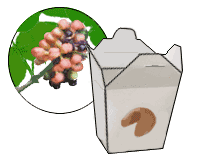Szechuan Peppercorns - Burn and Numb your Senses
Created | Updated Nov 6, 2006

Readers might ask why is it of any importance for one to know about this particular peppercorn. However, its 'stimulating' nature means that you might want to avoid it should you come across it.
What Is a Szechuan Peppercorn?
The Szechuan peppercorn1 is a spice native to the province of Szechuan, China. It is widely used in the local cuisine and is known by the name of huajiao, meaning 'flower pepper'. The spice is made from the dried outer casings of the berries of the Chinese prickly ash (Zanthoxylum simulans) which is a deciduous, evergreen shrub that has a height range between 4.60m to 7.60m. Although its berries are called 'peppercorns', the shrub does not in fact belong to the peppercorn family. It grows in the wild in the Szechuan Province on the low/medium level of the mountains, where the local farmers harvest the berries to be sold at the markets at the foot of the mountains. A berry consists of a black seed enclosed by a red casing. To prepare the actual spice used in cooking, the berries are dried; the black seeds, which have a bitter flavour, are removed. The red casings are then heated over a medium heat until smoking but not burnt. This process brings out the tantalisingly spicy flavour of the peppercorns. While these are still hot, they are ground into powder. Szechuan peppercorns are also sold whole.
Properties
The bark of Zanthoxylum simulans contains alkaloids2 and a volatile oil, while the berries themselves are rich in the volatile oil. The berries contain the alkamide herculin that causes a localised numbing effect on the tongue on consumption. The alkaloids extracted are often used to kill parasites. The berries themselves could burst under intense sunlight. Contact with the burst berries causes irritation of the skin in the form of a burning sensation. According to many Chinese medical trials, the oral use of the spice can alleviate the pain caused by indigestion, gallbladder diseases or ulcers as well as eliminating pinworms. However, the possible medical properties of the spice have not been tested in Western medical trials.
Role in Szechuan Cuisine
Spiciness is believed to rid the body of internal dampness and overcome the cold according to the traditional Chinese doctrine. Therefore, with the climate of the Szechuan province being wet and damp overall, while it can be cold where it rises into the surrounding mountain ranges, the peppercorn forms an essential part of Szechuan cuisine. One of the most famous is the Szechuan Hotpot - a tabletop deep wok heated with an over-generous amount of devilishly hot red chilli oil, garlic, scallions and most importantly a handful of Szechuan whole peppercorns in a clear soup. The continuous heating and boiling of the soup (you are provided with boiling kettles of water on the side for you to top up the wok when it is drying out) means that the 'spiciness' of the peppercorn is further released3 into the soup as the meal goes on. If you are lucky enough to participate in one of these meals with the locals, you will be able to observe the following:
Hotpots continue over scorching hot summers.
Even the locals are sweating with tears glittering in their eyes when they are at it - that makes you wonder how spicy it really must be. Considering they have hotpots extremely habitually and probably since they were children, you would have supposed that they would have built up a good level of 'spiciness' tolerance.
Fortunately it is a custom for the restaurants to provide you with packets of tissues to wipe your sweat, tears and very often to blow your runny nose. There is also a scorching sensation on the lips that gives the illusion of them having swollen to at least twice their original size.
First, second or third timers often experience indigestion (as if someone is trying to blow dry your stomach while applying methanol on its lining simultaneously) or unpleasant burning sensation during the long lavatory sessions after the meal. This is due to the vast quantity of chilli oil one has ingested, which the digestive system fails to assimilate. Thus the oil burns all the way along the alimentary canal right to the end.
Fried Hot Diced Chicken - Szechuan Style
The taste of Szechuan is salty, intense and extremely spicy. This is one of the least 'stimulating' local dishes.
Ingredients
- 7oz (200g) Chicken breasts and thighs
- 2tbsp Cornstarch (corn flour), dissolved in 2tbsp of water
- 1/8tsp Salt, or to taste
- 2tsp Rice wine
- 1/2tbsp Soy sauce
- 1 cup Stock
- 1tsp Sesame oil
- 1 Red hot chilli
- 1/2 cup (100ml) Vegetable oil
- 3-4 Slices of ginger, chopped into shreds
- 2tsp Scallions (spring onions), chopped
- A few garlic slices
- 1/8tsp MSG
- 1tbsp Chilli oil
Instructions
Skin, bone and dice the chicken. Blend 1 tbsp of the cornstarch water with 1 tsp of rice wine and some salt. Coat over the chicken. Leave to marinate.
In another bowl, mix the soy sauce, sesame oil, the remaining 1tbsp of cornstarch water and rice wine, together with the MSG. Leave on one side.
Peel and dice the water chestnuts. Seed the chillies and chop finely. Leave on one side.
Heat the oil in a wok over a high heat. Add the chilli oil and chilli pieces and fry for 30 seconds. Add and stir-fry the chicken until it acquires a red tint but is only about 70% cooked.
Add the ginger, water chestnuts, scallions and garlic. Fry until fragrant. Stir in the sauce and sprinkle with some vinegar. Fry for about 30 seconds. Ready to serve!

